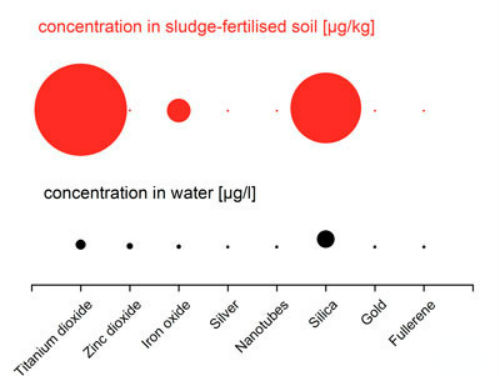|
NOVIDADES
To perform a risk assessment of nanomaterials in the environment, information on the exposure, i.e. the amounts that are present in the environment, is essential. In contrast to many other known pollutants, the concentrations of nanomaterials in environmental systems cannot be measured directly. In this situation, exposure modelling is a solution to estimate the environmental exposure with synthetic nanomaterials. Exposure modelling has already been successfully applied to many other pollutants. Thanks to the progress made over the last 10 years, adapted exposure models now allow quite accurate predictions of the quantities of nanomaterials in the environment[1-3, 6]. With the help of material flow analysis, the first step is to determine how many nanomaterials are released into the environment from production, use and disposal. In a second step, environmental fate models are used to predict the further behavior and distribution of nanomaterials within different environmental compartments such as water, air and soil.  Exposure models. Material flow analysis (left) and environmental behaviour modelling (right). The material flow analysis calculates the release of nanomaterials into the environment, environmental behaviour modelling describes the distribution in the environment. (Reprint and modified according to Nowack B. (2017)). Evaluation of environmental exposure models for engineered nanomaterials in a regulatory context. Image: NanoImpact, 8 38-47. with permission of Elsevier
Generally, nanomaterials produced in larger quantities have higher environmental concentrations than those who have only limited applications. However, the life-cycle of the nanoproducts has a large influence on the actual release. A large release occurs for example from cosmetics. Because of the efficient removal of nanomaterials during wastewater treatment, large amounts are transferred into sewage sludge. When sludge is used as fertiliser on agricultural fields, high concentrations of nanomaterials in these soils can be expected.  Predicted environmental concentrations of nanomaterials in surface waters and sludge-treated soils. Mostly, higher concentrations of nanomaterials are predicted in sludge-treated soils. This is due to the removal of nanomaterials in sewage treatment plant and the subsequent deposition in the sewage sludge. Image: Andreas Mattern/ UFZ Leipzig
The figure shows the predicted environmental concentrations (PEC) for some nanomaterials in surface waters and sewage-sludge treated soils. Most of the nanoparticles occur in water only in a concentration of less than one millionth gram per liter, some like nanosilver even only at a level of a billionth gram per liter. Similar calculations have been performed for other environmental compartments such as sediments and soils, but also concentrations in landfills and sewage sludge have been calculated. In sewage-sludge treated soils the concentrations of some nanomaterials like titanium dioxide are quite high and can reach even several milligrams per kilogram soil[2-7]. In general the amounts of nanomaterials in the environment can be predicted quite well using the method of exposure modelling. The modelled concentrations replace the measured environmental concentrations which cannot be obtained at the moment due to missing analytical methods. Modelled environmental concentrations are important in order to be able to make conclusions about possible effects in the environment and thus constitute one basis for environmental risk assessments. 2) ACS Environmental Science & Technology, "Dynamic Probabilistic Modeling of Environmental Emissions of Engineered Nanomaterials" 3) Science of The Total Environment, "Probabilistic modeling of the flows and environmental risks of nano-silica" 4) Nanotoxicology, "Are engineered nano iron oxide particles safe? an environmental risk assessment by probabilistic exposure, effects and risk modeling" 5) Journal of Nanobiotechnology, "Probabilistic modelling of prospective environmental concentrations of gold nanoparticles from medical applications as a basis for risk assessment" 6) Environmental Pollution, "Comprehensive probabilistic modelling of environmental emissions of engineered nanomaterials" 7) Environmental Science: Nano, "Redefining environmental nanomaterial flows: consequences of the regulatory nanomaterial definition on the results of environmental exposure models" DaNa2.0 (Data and knowledge on Nanomaterials). Posted: Apr 23, 2019. |
|||||||||||||||||||||||||